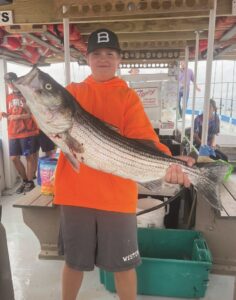We’ve had an up-and-down week fishing-wise. Bluefish were all over the bay early in the week: great catches were coming in from the Pamet to the Shoals, there were big schools of very large fish from the Race all the way to Head of the Meadow, and there were even bluefish at the Cottages at Beach Point.
At the same time we saw all these bluefish, striped bass, which uncharacteristically have bit well all summer, were still solid from the Race to the Peaked Hill Bar.
Then a strong cold front came through with some hard east and northeast winds. None of the boats got out for a day or so, and when we did get out, there wasn’t a fish to be found anywhere.
Water temperatures had dropped, though not as much as you might expect after such a storm. Still, the fish had taken off on us to parts unknown.

Slowly, the bass came back. First to the backside beaches and at the Race Station. Then the bluefish made an appearance, en masse, off Herring Cove and out to the Race. Our bluefish this year are brutes, by the way, with many in the 12-to-15-pound range.
It looks like we are having an entire summer of striped bass biting pretty much nonstop from the beginning of the season all the way to the end. This is not typical, but nobody’s complaining. In a little more than a month or so, these fish will begin their migration back south to the Hudson River and the Chesapeake Bay.
The whales off the Race Station Beach have been phenomenal. Groups of humpbacks have been feeding just far enough from shore to be mostly out of view to beachgoers. But those of us on fishing boats have had a real treat watching them feeding and breaching very nearby. There are also a pair of fin whales along with a few minke whales in the Race.
The hypoxia noticed off and on for several years at the southern end of the bay and now appearing in the waters off Provincetown, as reported last week in this newspaper, is a real concern. While fish can quickly exit a hypoxic area, the potential for a significant lobster die-off is very real. This is not just a warming seas issue.
I believe there are things we can do to counter it, because we know that excessive nutrients, such as nitrogen and phosphorus from old septic systems and lawn fertilizer on properties near the water, do enter the bay via rain runoff. That has to contribute to the seemingly mysterious algal blooms that are involved in the hypoxic process. When the algae die, the decomposing organic matter that results contributes significantly to lower oxygen levels in the water. This bears watching.
The effects of global warming on our oceans continue to bring us fish we’ve never seen here before. This past week, a barracuda was caught off Montauk Point in New York. Even more mind-blowing was the tarpon caught on the south shore of the Cape in New Seabury. These are both warm-water-dwelling tropical fish.
I have said this before, readers, and I’ll say it again: within 10 years we will be mahi-mahi fishing here, and our lobsters will have migrated north out of the bay, just as they are leaving Long Island Sound now. The handwriting is on the wall.
